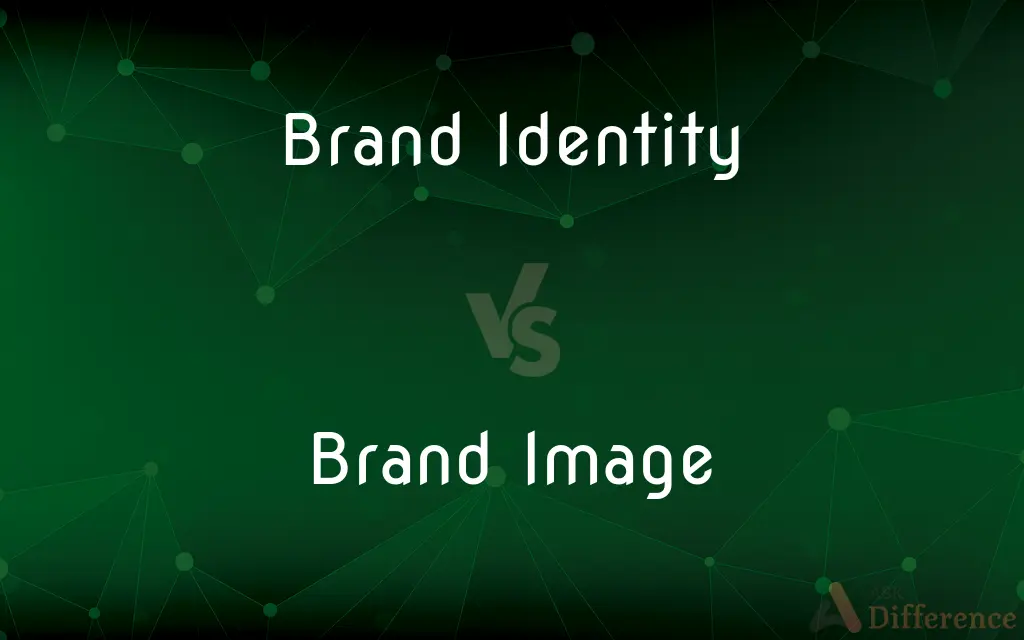Brand Identity vs. Brand Image — What's the Difference?
By Tayyaba Rehman & Fiza Rafique — Published on October 26, 2023
Brand Identity is how a brand presents itself to the world, while Brand Image is how the public perceives the brand.

Difference Between Brand Identity and Brand Image
Table of Contents
ADVERTISEMENT
Key Differences
Brand Identity represents the strategic choices and intentions set by a company. It encompasses the logo, color scheme, and other visual elements. On the other hand, Brand Image is the impression held by the audience about the brand. It's not always controlled by the company and may differ from its intended identity.
At its core, Brand Identity is about shaping perception. It's a company's way of communicating its values, beliefs, and purpose. In contrast, Brand Image is the reflection of this in the public's mind. It's the collective interpretation of all interactions with the brand.
A company can meticulously craft its Brand Identity through design, messaging, and strategy. Yet, Brand Image remains, to an extent, out of its hands, molded by customer experiences, media stories, and external conversations.
For businesses, understanding the nuances between Brand Identity and Brand Image is crucial. While the former can be controlled and fine-tuned, the latter requires active listening, feedback collection, and adaptation based on public sentiment.
A successful brand ensures that its Brand Identity aligns closely with its Brand Image. This means the company not only communicates effectively but also consistently delivers on its promises, ensuring public perception aligns with intent.
ADVERTISEMENT
Comparison Chart
Origin
Created and controlled by the company.
Formed by the public based on interactions and experiences.
Nature
Intentional and strategic.
Reactive and interpretive.
Components
Logo, color scheme, messaging, etc.
Public perceptions, beliefs, and emotions about the brand.
Control
Directly managed by the brand.
Influenced by external factors and public sentiment.
Purpose
Establish and communicate brand values and characteristics.
Reflect how the brand is perceived in the market.
Compare with Definitions
Brand Identity
A brand's self-expression and promise.
Adidas's sporty and dynamic vibe is central to its Brand Identity.
Brand Image
The external reputation of a brand.
McDonald's global popularity has crafted a familiar and friendly Brand Image.
Brand Identity
A brand's chosen presentation to its audience.
Nike's swoosh logo is a pivotal part of its Brand Identity.
Brand Image
The collective sentiment towards a brand.
Many consider Disney's Brand Image to be magical and family-friendly.
Brand Identity
The strategic representation of brand values.
Coca-Cola's red color and typography reflect its Brand Identity.
Brand Image
The perception of a brand by the public.
Tesla's Brand Image is associated with innovation and sustainability.
Brand Identity
The consistent look and feel across brand touchpoints.
Starbucks ensures its Brand Identity is coherent in every store.
Brand Image
Audience interpretation of brand interactions.
Due to its consistent service, Amazon has a trustworthy Brand Image.
Brand Identity
The tangible elements representing a brand.
Apple's minimalistic design approach is integral to its Brand Identity.
Brand Image
The emotional and perceptual stake in a brand.
Nike's empowering campaigns contribute to its positive Brand Image.
Common Curiosities
What's the primary distinction between Brand Identity and Brand Image?
Brand Identity is how a brand chooses to present itself, while Brand Image is the public's perception of the brand.
Is Brand Identity static?
While Brand Identity is more consistent, brands may evolve it over time to stay relevant.
Can a brand's Image differ from its Identity?
Yes, Brand Image can differ from Brand Identity based on public sentiment and experiences.
Which is directly controlled by the company: Brand Identity or Brand Image?
Brand Identity is directly controlled by the company, while Brand Image is influenced by external factors.
How can a brand align its Image with its Identity?
By ensuring consistent communication, delivering on promises, and actively addressing feedback to align Brand Image with Brand Identity.
Why is Brand Identity essential for a business?
Brand Identity helps in communicating a brand's values, differentiating it from competitors, and attracting its target audience.
How does media influence Brand Image?
Media stories, whether positive or negative, can significantly shape the public's Brand Image.
Can competitors influence a brand's Image?
Yes, competitor actions and campaigns can indirectly shape a brand's Brand Image in the market.
Can a negative incident impact a Brand Image?
Yes, negative incidents can harm a Brand Image, making reputation management crucial.
How can a company rectify a misaligned Brand Image?
Through active engagement, addressing concerns, consistent messaging, and delivering on promises to realign Brand Image.
Is rebranding a change in Brand Identity?
Yes, rebranding is a strategic overhaul of Brand Identity to better align with goals or market changes.
Are logos the only component of Brand Identity?
No, logos are just one aspect. Brand Identity encompasses all visual, auditory, and strategic brand elements.
Do both Brand Identity and Brand Image influence customer loyalty?
Yes, a coherent Brand Identity and positive Brand Image play pivotal roles in fostering customer loyalty.
How do customer reviews impact Brand Image?
Customer reviews significantly influence Brand Image as they shape public perception based on real experiences.
Why is it crucial to monitor Brand Image?
Monitoring Brand Image helps brands understand public sentiment, address concerns, and adapt strategies to stay relevant and favorable.
Share Your Discovery

Previous Comparison
Gratitude vs. Thankfulness
Next Comparison
Unitary Government vs. Federal GovernmentAuthor Spotlight
Written by
Tayyaba RehmanTayyaba Rehman is a distinguished writer, currently serving as a primary contributor to askdifference.com. As a researcher in semantics and etymology, Tayyaba's passion for the complexity of languages and their distinctions has found a perfect home on the platform. Tayyaba delves into the intricacies of language, distinguishing between commonly confused words and phrases, thereby providing clarity for readers worldwide.
Co-written by
Fiza RafiqueFiza Rafique is a skilled content writer at AskDifference.com, where she meticulously refines and enhances written pieces. Drawing from her vast editorial expertise, Fiza ensures clarity, accuracy, and precision in every article. Passionate about language, she continually seeks to elevate the quality of content for readers worldwide.
















































